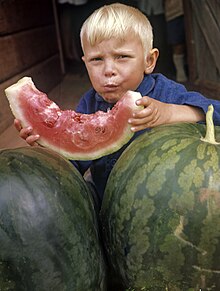Mouthfeel

Mouthfeel refers to the physical sensations in the mouth caused by food or drink, making it distinct from taste. It is a fundamental sensory attribute which, along with taste and smell, determines the overall flavor of a food item.[1][2] Mouthfeel is also sometimes referred to as texture.[2]
It is used in many areas related to the testing and evaluating of foodstuffs, such as wine-tasting and food rheology.[3] It is evaluated from initial perception on the palate to first bite, through chewing to swallowing and aftertaste. In wine-tasting, for example, mouthfeel is usually used with a modifier (big, sweet, tannic, chewy, etc.) to the general sensation of the wine in the mouth.[4] Research indicates texture and mouthfeel can also influence satiety with the effect of viscosity most significant.[5]
Mouthfeel is often related to a product's water activity—hard or crisp products having lower water activities and soft products having intermediate to high water activities.[6]
Qualities perceived
- Chewiness: The sensation of sustained, elastic resistance from food while it is chewed
- Cohesiveness: The degree to which the sample deforms before rupturing when biting with molars
- Crunchiness: The audible grinding of a food when it is chewed
- Density: The compactness of cross section of the sample after biting completely through with the molars
- Dryness: The degree to which the sample feels dry in the mouth
- Exquisiteness: The perceived quality of the item in question
- Fracturability: The force with which the sample crumbles, cracks or shatters – Fracturability encompasses crumbliness, crispiness, crunchiness and brittleness.
- Graininess: The degree to which a sample contains small grainy particles
- Gumminess: The energy required to disintegrate a semi-solid food to a state ready for swallowing
- Hardness: The force required to deform the product to a given distance, i.e., force to compress between molars, bite through with incisors, compress between tongue and palate
- Heaviness: The weight of product perceived when first placed on tongue
- Juiciness
- Moisture absorption: The amount of saliva absorbed by product
- Moisture release: The amount of wetness/juiciness released from sample
- Mouthcoating: The type and degree of coating in the mouth after mastication (for example, fat/oil)
- Roughness: The degree of abrasiveness of product's surface perceived by the tongue
- Slipperiness: The degree to which the product slides over the tongue
- Smoothness: The absence of any particles, lumps, bumps, etc., in the product
- Uniformity: The degree to which the sample is even throughout or the homogeneity of the sample
- Uniformity of bite: The evenness of force throughout the bite
- Uniformity of chew: The degree to which the chewing characteristics of the product are even throughout mastication
- Viscosity: The force required to draw a liquid from a spoon over the tongue
- Wetness: The amount of moisture perceived on product's surface
See also
References
- ^ Mouritsen, Ole G.; Styrbæk, Klavs (2017). Mouthfeel: How Texture Makes Taste. Columbia University Press. ISBN 978-0-231-54324-8.
- ^ a b Guinard, Jean-Xavier; Mazzucchelli, Rossella (July 1996). "The sensory perception of texture and mouthfeel". Trends in Food Science & Technology. 7 (7): 213–219. doi:10.1016/0924-2244(96)10025-X.
- ^ Goodwin, Lindsey (26 December 2017). "Mouthfeel Defined". The Spruce. Retrieved 14 January 2018.
- ^ Dollase, Jürgen (2005). Geschmacksschule (in German). Wiesbaden, Germany: Tre Torri Verlag. ISBN 978-3-937963-20-4.
- ^ Stribiţcaia, Ecaterina; Evans, Charlotte E. L.; Gibbons, Catherine; Blundell, John; Sarkar, Anwesha (2020-07-31). "Food texture influences on satiety: systematic review and meta-analysis". Scientific Reports. 10 (1): 12929. Bibcode:2020NatSR..1012929S. doi:10.1038/s41598-020-69504-y. ISSN 2045-2322. PMC 7395742. PMID 32737349.
- ^ Katz, E. E.; Labuza, T. P. (March 1981). "Effect of Water Activity on the Sensory Crispness and Mechanical Deformation of Snack Food Products". Journal of Food Science. 46 (2): 403–409. doi:10.1111/j.1365-2621.1981.tb04871.x.
Further reading
- Dollase, Jürgen, Geschmacksschule [engl.: Tasting School], 2005 Tre Tori, Wiesbaden, Germany (ISBN 3937963200). German-language textbook by a renowned food critic covering some, but not all of the above mentionend properties/mouthfeelings.
- Stokes, Jason R.; Boehm, Michael W.; Baier, Stefan K. (August 2013). "Oral processing, texture and mouthfeel: From rheology to tribology and beyond". Current Opinion in Colloid & Interface Science. 18 (4): 349–359. doi:10.1016/j.cocis.2013.04.010.
